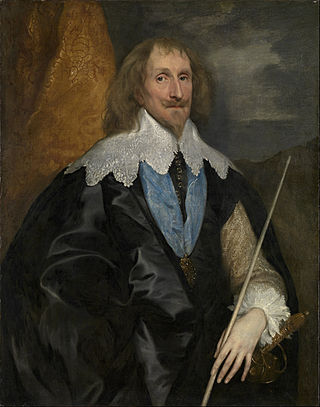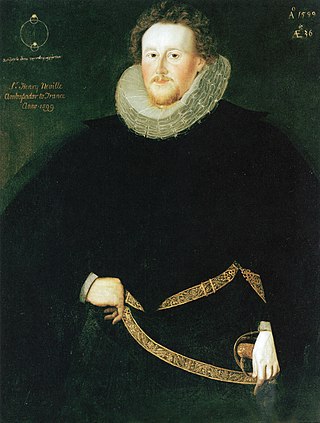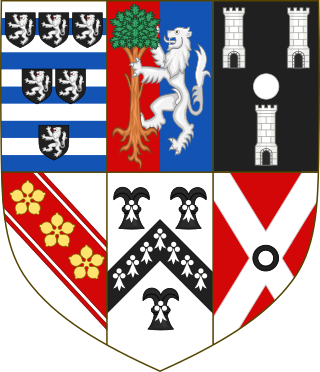
Earl of Suffolk is a title which has been created four times in the Peerage of England. The first creation, in tandem with the creation of the title of Earl of Norfolk, came before 1069 in favour of Ralph the Staller; but the title was forfeited by his heir, Ralph de Guader, in 1074. The second creation came in 1337 in favour of Robert de Ufford; the title became extinct on the death of his son, the second Earl, in 1382. The third creation came in 1385 in favour of Michael de la Pole. The fourth creation was in 1603 for Lord Thomas Howard, the second son of Thomas Howard, 4th Duke of Norfolk, by his second wife Margaret Audley, the daughter and eventual sole heiress of Thomas Audley, 1st Baron Audley of Walden, of Audley End in the parish of Saffron Walden in Essex. Howard was a prominent naval commander and politician and served as Earl Marshal, as Lord Chamberlain of the Household and as Lord High Treasurer. In 1597 he was summoned to Parliament as Baron Howard de Walden, and in 1603 he was further honoured, at the start of the reign of King James I, when he was created Earl of Suffolk. His second son the Hon. Thomas Howard was created Earl of Berkshire in 1626.

Earl of Berkshire is a title that has been created twice in the Peerage of England. It was created for the first time in 1621 for Francis Norris, 1st Earl of Berkshire. For more information on this creation, see the Earl of Abingdon and also the Earl of Lindsey. The second creation came in 1626 in favour of Thomas Howard, 1st Viscount Andover. He was the second son of Thomas Howard, 1st Earl of Suffolk, second son of the second marriage of Thomas Howard, 4th Duke of Norfolk. His mother was Katherine, daughter of Sir Henry Knyvett of Charlton in Wiltshire. Howard had already been created Baron Howard of Charlton, in the County of Wiltshire, and Viscount Andover, in the County of Southampton, in 1622. These titles are also in the Peerage of England. Lord Berkshire succeeded to the Charlton estate through his mother in 1638. He was succeeded by his eldest son, the second Earl. He had already in 1640 been summoned to the House of Lords through a writ of acceleration in his father's junior title of Baron Howard of Charlton. He had no sons and on his death in 1679 the titles passed to his younger brother, the third Earl. He represented Wallingford in the House of Commons. He also died without male issue and was succeeded by his great-nephew, the fourth Earl. He was the grandson of the Hon. William Howard, fourth son of the first Earl. In 1745 he succeeded his third cousin as eleventh Earl of Suffolk. For further history of the titles, see the Earl of Suffolk.

Thomas Howard, 1st Earl of Suffolk,, of Audley End House in the parish of Saffron Walden in Essex, and of Suffolk House near Westminster, a member of the House of Howard, was the second son of Thomas Howard, 4th Duke of Norfolk, by his second wife Margaret Audley, the daughter and eventual sole heiress of Thomas Audley, 1st Baron Audley of Walden, of Audley End.

Catherine Carey, after her marriage Catherine Knollys and later known as both Lady Knollys and Dame Catherine Knollys,, was chief Lady of the Bedchamber to Queen Elizabeth I, who was her first cousin.

Katherine Howard, Countess of Suffolk was an English court office holder who served as lady-in-waiting to the queen consort of England, Anne of Denmark.

James Ley, 1st Earl of Marlborough was an English judge and politician who sat in the House of Commons at various times between 1597 and 1622. He was Lord Chief Justice of the King's Bench in Ireland and then in England, and was Lord High Treasurer from 1624 to 1628. On 31 December 1624, James I created him Baron Ley, of Ley in the County of Devon, and on 5 February 1626, Charles I created him Earl of Marlborough. Both titles became extinct upon the death of the 4th Earl of Marlborough in 1679.

Philip Herbert, 4th Earl of Pembroke and 1st Earl of Montgomery, was an English courtier, nobleman, and politician active during the reigns of James I and Charles I. He married Susan de Vere, the youngest daughter of Edward de Vere, 17th Earl of Oxford, the Oxfordians' William Shakespeare. Philip and his older brother William were the 'incomparable pair of brethren' to whom the First Folio of Shakespeare's collected works was dedicated in 1623.

Sir Henry Neville was an English courtier, politician and diplomat, noted for his role as ambassador to France and his unsuccessful attempts to negotiate between James I of England and the Houses of Parliament. In 2005, Neville was put forward as a candidate for the authorship of Shakespeare's works.
Knollys, Knolles or Knowles, the name of an English family descended from Sir Thomas Knollys, Lord Mayor of London, possibly a kinsman of the celebrated general Sir Robert Knolles. The next distinguished member of the family was Sir Francis Knollys or Knowles, English statesman, son of Sir Robert Knollys, or Knolles, a courtier in the service and favour of Henry VII and Henry VIII. Robert had also a younger son, Sir Henry, who took part in public life during the reign of Elizabeth I and who died in 1583. Lettice Knollys was pronounced the most prominent member of the family, from her birth in 1543 until her death in 1634.

William Cecil, 2nd Earl of Exeter,, known as the third Lord Burghley from 1605 to 1623, was an English nobleman, politician, and peer.

William Cecil, 2nd Earl of Salisbury,, known as Viscount Cranborne from 1605 to 1612, was an English peer, nobleman, and politician.

Sir Heneage Finch was an English lawyer, Member of Parliament, and politician who sat in the House of Commons at various times between 1607 and 1626. He was Speaker of the English House of Commons in 1626.

Sir Walter Cope of Cope Castle in the parish of Kensington, Middlesex, England, was Master of the Court of Wards, Chamberlain of the Exchequer, public Registrar-General of Commerce and a Member of Parliament for Westminster.
Charles Howard, 2nd Earl of Berkshire KB was an English peer, styled Viscount Andover from 1626 to 1669, was the eldest son of Thomas Howard, 1st Earl of Berkshire and his wife Lady Elizabeth Cecil.

Sir Oliver St John, 1st Viscount Grandison was an English soldier and politician who became Lord Deputy of Ireland.

Francis Norris, 1st Earl of Berkshire was an English nobleman and courtier.

Sir Thomas Jermyn (1573–1645) of Rushbrooke, Suffolk, was an English Royalist soldier and politician who was a Member of Parliament between 1604 and 1640. He became an influential courtier and served as Comptroller of the Household to Charles I from 1639 to 1641.















